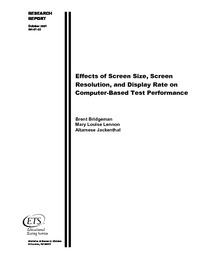Effects of Screen Size, Screen Resolution, and Display Rate on Computer-Based Test PerformanceBrent Bridgeman, Mary Louise Lennon, Altamese Jackenthal
Publikationsdatum:
|
 |
 Diese Seite wurde seit 5 Jahren inhaltlich nicht mehr aktualisiert.
Unter Umständen ist sie nicht mehr aktuell.
Diese Seite wurde seit 5 Jahren inhaltlich nicht mehr aktualisiert.
Unter Umständen ist sie nicht mehr aktuell.
 Zusammenfassungen
Zusammenfassungen
Computer-based tests administered in established commercial testing centers typically have used
monitors of uniform size running at a set resolution. Web-based delivery of tests promises to
greatly expand access, but at the price of less standardization in equipment. The current study
evaluated the effects of variations in screen size, screen resolution, and presentation delay on
verbal and mathematics scores in a sample of 357 college-bound high school juniors. The
students were randomly assigned to one of six experimental conditionsthree screen display
conditions crossed with two presentation rate conditions. The three display conditions were:
a 17-inch monitor set to a resolution of 1024 x 768, a 17-inch monitor set to a resolution of
640 x 480, and a 15-inch monitor set to a resolution of 640 x 480. Items were presented either
with no delay or with a five-second delay between questions (to emulate a slow Internet
connection).
No significant effects on math scores were found. Verbal scores were higher, by about a quarter of a standard deviation (28 points on the SAT® scale), with the high-resolution display.
Von Brent Bridgeman, Mary Louise Lennon, Altamese Jackenthal im Text Effects of Screen Size, Screen Resolution, and Display Rate on Computer-Based Test Performance (2001) No significant effects on math scores were found. Verbal scores were higher, by about a quarter of a standard deviation (28 points on the SAT® scale), with the high-resolution display.
 Dieser Text erwähnt ...
Dieser Text erwähnt ...
 Volltext dieses Dokuments
Volltext dieses Dokuments
 |  Effects of Screen Size, Screen Resolution, and Display Rate on Computer-Based Test Performance: Artikel als Volltext ( Effects of Screen Size, Screen Resolution, and Display Rate on Computer-Based Test Performance: Artikel als Volltext ( : :  , 357 kByte; , 357 kByte;  : :  2021-03-21) 2021-03-21) |
 Anderswo suchen
Anderswo suchen 
 Beat und dieser Text
Beat und dieser Text
Beat hat Dieser Text während seiner Zeit am Institut für Medien und Schule (IMS) ins Biblionetz aufgenommen. Beat besitzt kein physisches, aber ein digitales Exemplar. Eine digitale Version ist auf dem Internet verfügbar (s.o.). Aufgrund der wenigen Einträge im Biblionetz scheint er es nicht wirklich gelesen zu haben. Es gibt bisher auch nur wenige Objekte im Biblionetz, die dieses Werk zitieren.










 Biblionetz-History
Biblionetz-History